Mastering Oahu Weather Maps for Kiteboarding Success
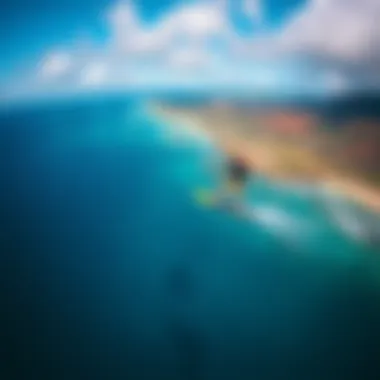
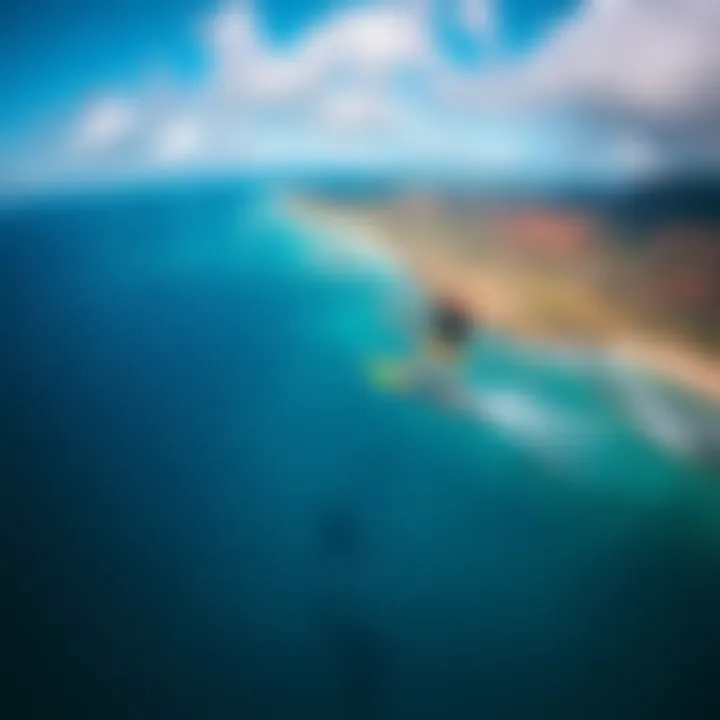
Intro
Kiteboarding on Oahu is more than just a sport; it's an experience crafted by a mix of wind, water, and the right gear. For those looking to harness the skies, understanding the local weather patterns is of utmost significance. Oahu's unique geography shapes its winds and currents, making its weather maps invaluable for kiteboarders. Knowledgeable riders know that being well-prepared can mean the difference between a thrilling day on the water and a frustrated return to the beach.
This guide dissects the essential aspects of weather maps specific to Oahu, shedding light on how to interpret these crucial tools. From novice kiteboarders to those with years of experience under their harness, the aim here is to demystify the complexities of weather conditions and explain their importance in planning a successful day of kiteboarding.
As we dive deeper, we'll cover the necessary gear, pivotal techniques, and tips to help you sail through the winds of Oahu, enhancing your kiteboarding adventure.
Gear and Equipment
A successful kiteboarding experience starts with understanding your gear. It’s one thing to have a kite that looks flashy, but it’s another to own gear that suits your skill level and the conditions on the water. Whether you are a newcomer or a seasoned pro, having the right equipment is non-negotiable.
Essential Kiteboarding Gear for Beginners
For beginners, simplicity is key. Consisting of only a few vital components, the right setup can boost confidence and safety:
- Kite and Bar: A suitable, user-friendly kite paired with a comfortable control bar sets the stage for a smoother experience.
- Harness: Select a harness that fits well—both seat and waist harness can have their advantages.
- Board: Opt for a larger board that provides stability and ease of handling in the water.
- Safety Gear: Don't overlook the importance of a helmet and impact vest for added protection.
Having these basics ensures that you can focus on improving your skills, rather than getting caught up in gear complexities. Beginners often overlook the significance of ensuring all equipment is in top condition, so regular checks and maintenance are a must.
Advanced Equipment for Experienced Riders
Once you've mastered the basics, the gear can become your secret weapon. Experienced kiteboarders typically invest in gear tailored for performance:
- High-Performance Kites: Advanced riders might gravitate towards specific kites designed for freestyle or wave riding, capable of handling stronger winds.
- Custom Boards: A tailored board can enhance riding style and efficiency in various conditions;
- Advanced Harnesses: Choose enhanced harnesses that offer more support and freedom of movement.
Experimenting with different gear can be enlightening, allowing riders to refine their technique and transcend their limitations.
Eager kiteboarders will often research various equipment sources to ensure they make informed purchases.
"The right gear doesn’t just improve performance; it enhances safety and enjoyment on the water."
Techniques and Tips
Mastering kiteboarding is not solely based on having great gear. It's also about harnessing techniques and tips that can elevate your riding experience.
Basic Riding Techniques for Newbies
Starting with the fundamentals will help build a solid foundation:
- Kite Control: Learning to steer and keep your kite at the correct angle is crucial.
- Body Position: Stay balanced—keep your weight centered and your knees slightly bent.
- Starting and Stopping: Practice launching your kite smoothly and find how to signal for a stop without panic.
These basic techniques, when practiced consistently, will facilitate a smoother learning curve.
Expert Tricks to Elevate Your Skills
For those who have mastered the fundamentals, adding some flair will not only boost confidence but also impress:
- Jumps and Spins: Once comfortable in the air, practicing controlled jumps can enhance your aerial skill set.
- Transitions: Learning to seamlessly change from toe-side to heel-side can help give the smooth rides one desires.
As one delves deeper into the art of kiteboarding, it’s essential to revisit and adapt to local weather conditions, utilizing maps to make informed judgments about when and where to ride.
Armed with the right gear and effective techniques, kiteboarding in Oahu becomes an exhilarating endeavor, shaping unforgettable memories on its stunning shores.
Preface to Oahu's Climate
Understanding Oahu's climate is not just about grasping averages and patterns; it's about grasping opportunities, especially for kiteboarding enthusiasts. This tropical paradise isn't just a backdrop for thrills; the weather here plays a vital role in shaping your experience on the water. With consistent trade winds, varied precipitation, and temperature fluctuations across the island, knowing how to navigate the climatic nuances can make or break a kiteboarding adventure.
Like an artist with a palette, each kiteboarder has a unique preference for conditions, making awareness of the local weather all the more significant. It's not merely about enjoying sunny skies; it's also about recognizing when the winds will be in your favor or when an unexpected downpour might turn your beach day into a soggy affair.
Overview of Oahu's Weather
Oahu experiences a typical tropical climate characterized by warm temperatures and varying humidity levels. The average temperature hovers around 70 to 85 degrees Fahrenheit, but it's not just about the heat. The island's weather can shift more quickly than a kite flapping in the breeze. You can be sunbathing in Waikiki one minute and find dark clouds bringing rain only moments later.
Key elements of Oahu’s weather include:
- Trade Winds: Revitalizing and reliable winds that blow steadily from the northeast, offering prime conditions for kiteboarding.
- Seasonal Variability: Two distinct seasons—wet (November to March) and dry (April to October)—meaning gear preparation is crucial.
- Microclimates: Different areas show their own weather traits. The North Shore could be experiencing rain while South Shore is basking in sunshine.
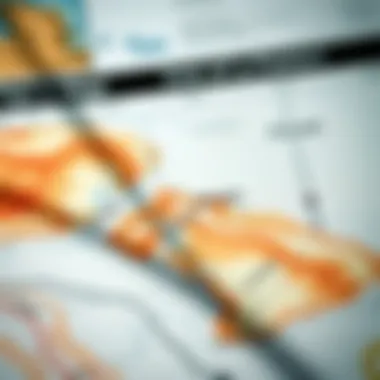
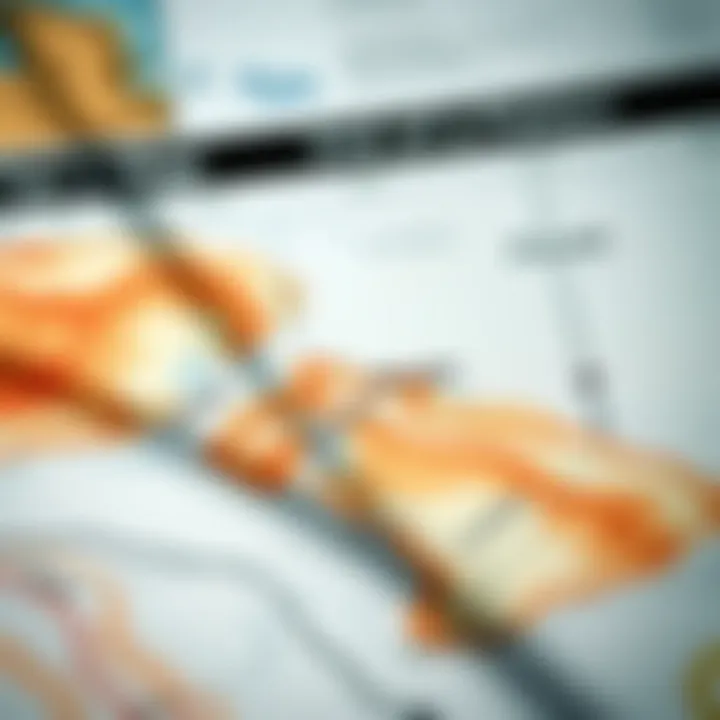
Significance for Kiteboarding
What does all this mean for kiteboarders? Quite a bit, actually. The interplay of wind and waves directly influences kiteboarding conditions, creating the perfect playground when you know what to look for. Understanding local weather maps becomes a lifeline for choosing the right moment to hit the water. Let's break down why this insight is indispensable:
- Optimal Riding Conditions: Familiarity with wind patterns allows enthusiasts to maximize their ride time under ideal conditions—less time guessing and more time gliding.
- Safety First: Recognizing potential storm patterns and weather fluctuations can safeguard against dangerous situations.
- Skill Development: Experiencing varying weather situations helps in honing skills. Gusts and lulls teach adaptability critical for various skill levels.
- Community Knowledge: Tapping into the local kiteboarding community’s wisdom about how the weather varies can lead to hidden spots or best times to ride.
By tailoring your knowledge of Oahu's weather to your kiteboarding plans, you can elevate your adventure level dramatically, turning potential mishaps into lessons learned in the wind.
Components of a Weather Map
Understanding the components of a weather map is essential for kiteboarding enthusiasts who want to harness the winds and weather conditions of Oahu. Knowledge of these elements will not only help in mapping out your kiteboarding excursions but also in making informed decisions that can significantly improve your experience on the water. With varying winds and temperatures throughout the day, understanding these maps is crucial for you to catch the optimal wind at the right time.
Understanding Symbols and Colors
When you first glance at a weather map, you might think it looks like a colorful puzzle. Each symbol and color represents unique weather conditions crucial for kiteboarding. The colors on these maps typically depict areas of high and low pressure, temperature gradients, or precipitation levels. For example, deep blues often indicate cooler temperatures, while yellows and reds might signal warmer air masses.
Common Symbols and Their Meanings:
- Triangles or half circles often indicate wind direction; the pointed end shows where the wind is coming from.
- Rain droplets may signal areas of precipitation, alerting you to possible wet conditions.
- Cloud icons can represent overcast skies, which may impact visibility and thermals.
Understanding these visual cues can guide you in deciding whether to head out for a kiteboarding session. If, for example, you see a cluster of red shades indicating rising temperatures along with strong wind direction symbols, it may just be a prime time to hit the beach.
Reading Temperature and Precipitation Indicators
Temperature and precipitation indicators on weather maps play a vital role in kiteboarding planning. As a kiteboarder, you want favorable wind conditions without being caught in unexpected rain or extreme heat.
- Temperature Readers: The temperature is usually displayed numerically, with color coding indicating warmer or cooler air. Warmer temperatures can enhance the thermal winds, ideal for kiteboarding, especially in the afternoon when the sun further warms the land.
- Precipitation: Maps often indicate precipitation levels through dashed lines or shades of blue or green. Light green might mean a light drizzle, while deep blue can indicate heavy rain. It’s critical to check these indicators, as kiteboarding in rain can reduce visibility and compromise safety.
By regularly interpreting these indicators, you can adjust your kiteboarding schedule more effectively. As a rule of thumb, aim to ride when the map illustrates sunny conditions with moderate winds and temperatures between 75°F to 85°F.
"Kiteboarding is as much about understanding the elements as it is about skill and equipment. Familiarity with the weather maps can give you the edge you need to ride those winds successfully."
Seasonal Weather Patterns in Oahu
Understanding the seasonal weather patterns in Oahu is like cracking the code to a secret, rewarding experience. For kiteboarding enthusiasts, recognizing these patterns means harnessing nature to maximize one’s time on the water. Oahu isn’t just a popular spot for tourists; it offers some of the finest kiteboarding conditions in the world, but you have to know when to ride the waves and when to stay on the shore.
Wet vs. Dry Seasons
Oahu experiences two distinct seasons: the wet season and the dry season, each with its unique characteristics. The wet season spans from November to March. During this time, the island gets more rain, especially in the northern and eastern parts. The rain usually comes in short bursts, meaning you can still catch some wind and waves between the showers. However, the threat of storms increases, and they can disrupt a planned kiteboarding session.
In contrast, the dry season, running from April to October, sees significantly less rainfall. This period is characterized by clearer skies and more stable weather conditions, making it the prime time for kiteboarding. The moisture in the air can create excellent wind conditions. Kiteboarders often find gusty trade winds that make for exhilarating rides.
Key Points of Wet and Dry Seasons:
- Wet Season:
- Dry Season:
- Higher chances of rain, especially in November to March.
- Short, intense showers; storm patterns can develop.
- Good for those looking for fewer crowds but with unpredictable weather.
- April to October brings lower humidity and clearer skies.
- More stable winds ideal for kiteboarding.
- Recommended for planning kiteboarding trips.
Best Times for Kiteboarding
Knowing the best times for kiteboarding in Oahu is like holding onto a golden ticket. As discussed, the dry season is undoubtedly the best choice. Specifically, the months of May through September are often viewed as the crème de la crème for kiteboarders. Wind conditions during these months tend to be consistent, usually flowing in from the northeast. During these warm months, riders can find steady winds averaging between 15 to 25 knots, which offer thrilling experiences for both novice and advanced kiteboarders alike.
It’s wise to focus on specific times of the day as well. Late mornings to early afternoons typically showcase peak wind strength in Oahu, while the evening hours often calm down—you might want to consider that for your land-based activities or simply enjoying the sunset.
Best Times for Kiteboarding:
- Months: May - September
- Wind Conditions:
- Daily Focus: Late morning to early afternoon for peak performance.
- Consistent northeast trade winds, 15-25 knots.
By knowing these seasonal patterns, kiteboarders can better plan their adventures, ensuring a more rewarding experience on the water. Knowledge is power, especially in the unpredictable realm of outdoor sports. So, whether you’re hunting for that perfect gust or navigating stormy weather, being prepared can make all the difference.
Wind Patterns and Their Impacts
When kiteboarding in Oahu, understanding the local wind patterns can be the difference between a breathtaking day on the water and a challenging outing. Wind not only determines the feasibility of kiteboarding but also significantly impacts performance, control, and overall experience. Whether it’s the steady trade winds that sweep across the coast or the more unpredictable localized winds, recognizing these patterns can enhance safety and enjoyment while riding the waves.
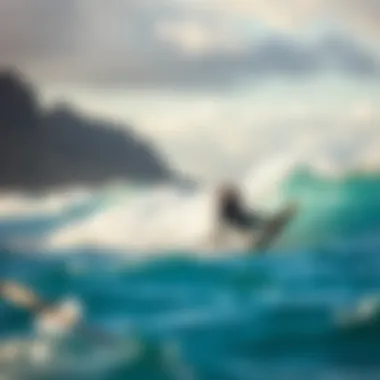
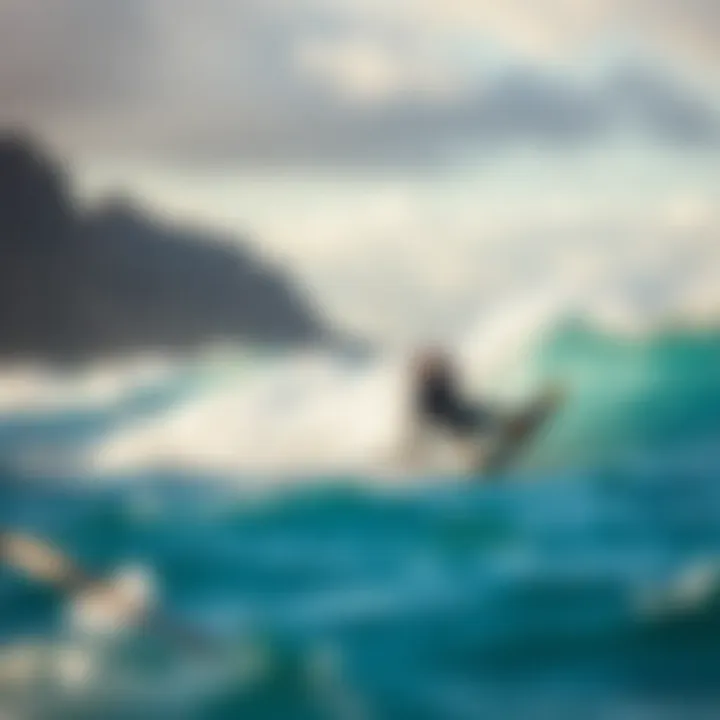
Trade Winds and Localized Winds
Trade winds are the mainstay of Oahu's weather, blowing consistently from the northeast. These winds generally come in strong, providing ideal conditions for kiteboarding. Here are a few key points about them:
- Consistency: The trade winds are reliable, maintaining a steady direction most days of the year, which helps kiteboarders predict when they can catch optimal winds.
- Speed Variability: Typically, wind speeds range from 15 to 25 knots, making it favorable for a wide array of skill levels — from beginners to seasoned pros.
- Localized Winds: In addition to trade winds, Oahu experiences localized winds caused by geographical features, such as mountains. These winds can vary significantly, meaning they may change quickly and unexpectedly. It is crucial for riders to pay attention to the forecasts and possibly even the current wind conditions at specific spots to make the best out of their kiteboarding outing.
Trade winds are often your best friends when kiteboarding, but keep an eye on your surroundings for sudden wind shifts.
Effects of Wind on Kiteboarding Performance
Wind directly influences how well a kiteboarder performs on the water. Various factors contribute to this relationship:
- Lift and Drag: The amount of wind and its direction plays a critical role in generating lift for the kite. Inadequate wind can lead to poor lift, making it tough to maintain altitude. Conversely, overly strong winds can create too much lift, risking control and safety.
- Control and Steering: Proper wind conditions allow for easier steering and responsive controls. Wind that shifts suddenly can catch riders off guard, leading to perilous situations. Understanding both the strength and direction of the winds helps in fine-tuning control techniques, crucial for executing tricks and maneuvers safely.
- Board Speed and Maneuverability: Wind impacts how fast you can travel across the water. In conditions with consistent winds, riders often find it easier to gain speed and perform complex tricks. On the flip side, gusty winds can hinder speed, affecting overall ride quality.
Kiteboarders should consistently evaluate wind maps and stay informed about their physical environment during their outings. This knowledge allows for adjustments in equipment choice, skill adaptation, and safety protocols, ultimately enhancing the kiteboarding experience in Oahu’s dynamic conditions.
Tropical Storms and Their Implications
Tropical storms are indeed a significant aspect of Oahu’s weather landscape. For kiteboarding enthusiasts, these storms can transform ideal kiteboarding conditions into moments of peril. Yes, it’s essential to recognize the possibility of storms forming as they can appear pretty quick and out of nowhere. Being informed not only enhances safety but also preserves the joyful kiteboarding experience.
Identifying Storm Patterns on Weather Maps
Understanding how to identify storm patterns on weather maps is a vital skill for kiteboarders. Weather maps often depict areas of low pressure where storms typically form. These low-pressure zones can manifest as swirling patterns and are often indicated in shades of yellow or red. Here are some pointers on reading these maps effectively:
- Look for convergence lines: These are areas where winds meet and can signal potential storm development.
- Check for satellite imagery: Active satellite images can provide real-time updates on storm progression.
- Pay attention to isobars: Closely spaced isobars indicate strong winds which can accompany storms.
By training your eye to recognize these patterns, you’ll have more confidence in making informed decisions about when to head out.
Safety Precautions for Kiteboarders
As with any outdoor activity, safety should be at the forefront of kiteboarding, especially regarding tropical storms. Here are some prudent measures to consider:
- Monitor local forecasts regularly: Platforms like NOAA and local weather sites offer detailed predictions and warnings.
- Have a clear exit strategy: Know where to land and how to pack up your gear quickly when the weather takes a turn.
- Invest in reliable gear: Ensure your kite and harness are up to par; quality equipment withstands varying conditions better.
- Join local forums or communities: Places like Reddit or kiteboarding clubs can provide real-time alerts or experiences from fellow kiters.
“Preparedness is key. By being aware of changing conditions, you can ensure your kitboarding adventures remain exciting and safe.”
Tying everything back to personal experiences might also help in better understanding the implications of tropical storms. Each run on the waves can teach you something new—like knowing when the clouds are beginning to roll in, or when that unsettling wind shift signals it’s time to pack up.
By remaining alert and informed, kiteboarders can continue to enjoy the thrill of Oahu's waters while navigating the unpredictable nature of tropical storms.
Utilizing Online Resources for Accurate Forecasting
In today’s fast-paced world, leveraging online resources for accurate forecasting can make or break a kiteboarding session. The unpredictable nature of Oahu’s weather can often leave even seasoned kiteboarders scratching their heads. Thus, having a firm grasp on where to find accurate and timely weather information is pivotal. This section delves into the nitty-gritty of using online tools to ensure your sessions are both enjoyable and safe.
Popular Websites and Applications
When it comes to gathering reliable weather data, various websites and applications take the spotlight. Some notable ones include:
- Windy.com: Renowned for its detailed wind forecasts, Windy offers real-time data that is crucial for kiteboarders. The interface is user-friendly and provides multiple views of wind patterns.
- Kiteplanner: This platform focuses explicitly on kiteboarding conditions, giving localized updates on wind speeds, tides, and suggested spots based on your preferences.
- NOAA Weather Service: As the go-to source for official weather forecasts, NOAA provides comprehensive radar and satellite imagery, helping riders understand precipitation and other factors at play.
- Windfinder: Another excellent resource for kiteboarders, Windfinder offers in-depth analysis of wind conditions at various spots throughout Oahu.
These platforms not only present the data but often have communities within them. Engaging with fellow kiteboarders can lead to discovering hidden gems or local tips that you might not find elsewhere.
Evaluating Forecast Accuracy
Knowing how to evaluate the accuracy of forecasts you find online is just as crucial as the information itself. Here are some practical approaches to gauge forecast reliability:
- Compare Multiple Sources: It’s wise to check several platforms. If multiple sites agree on the same conditions, you can bet your last dollar it’s probably accurate.
- Look at User Reviews: Websites like Reddit have active communities that often discuss individual experiences with forecasts. Feedback about what worked or didn't can be invaluable.
- Examine Historical Data: Many sites provide access to past weather data. Analyzing past conditions can help you draw parallels and assess whether current forecasts align with historical trends.
- Stay Updated: Weather can change in a heartbeat. It’s critical to regularly check updates, especially if you’re making plans that depend on weather conditions.
Local Knowledge and Community Insights
Gaining a deeper understanding of Oahu’s weather conditions goes far beyond what basic forecasts can offer. Local knowledge and community insights prove invaluable to kiteboarders, especially those looking to enhance their experiences on the water. While weather maps provide a framework, it’s the lived experiences and observations of local riders that can fill in the gaps.
For kiteboarders, the benefits of tapping into community insights include:
- Real-Time Updates: Weather can change in the blink of an eye in Oahu. Engaging with others in the community puts you in touch with reliable, informal information, ensuring you’re aware of unexpected shifts in conditions.
- Spot Recommendations: Locals often know the best kiteboarding spots for varying wind and wave conditions, which aren’t always documented in guides or maps.
- Safety Tips: Local enthusiasts can share invaluable advice on which spots might have hidden hazards or currents that are crucial for a safe experience.
Participating in the local kiteboarding community also fosters a sense of belonging. It can transform a solo kiteboarding session into a shared adventure.
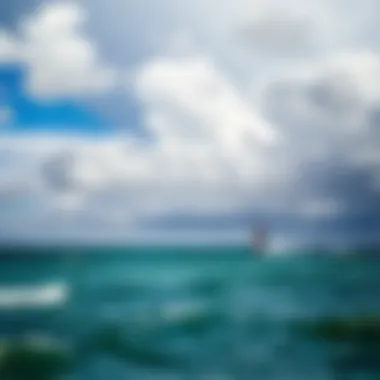
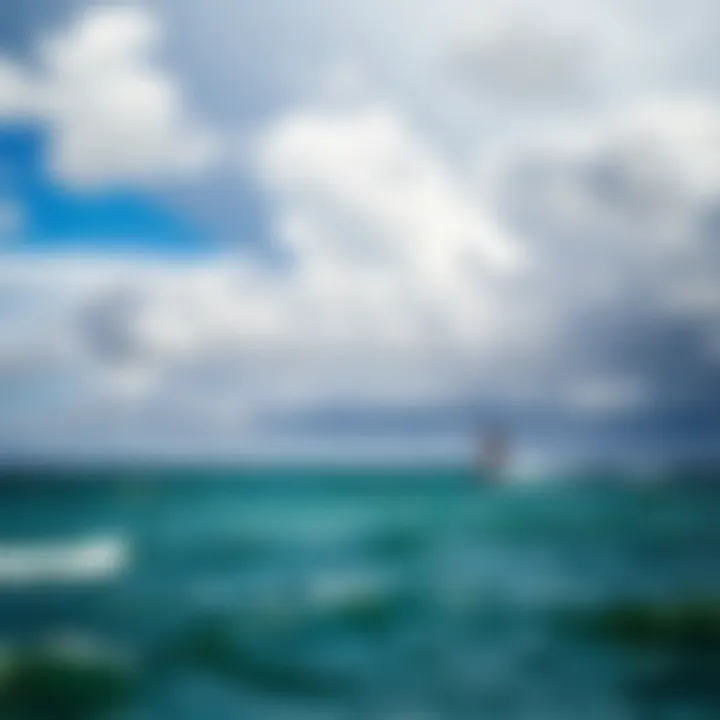
Connecting with Other Kiteboarders
Whether you’re a seasoned rider or a beginner, connecting with fellow kiteboarders offers a wealth of knowledge. Social platforms like Facebook or Reddit host groups specifically aimed at Oahu’s kiteboarding scene. Here, members exchange thoughts on gear, techniques, and, crucially, weather patterns.
In these spaces, one can share insights like:
- What winds work best on certain days?
- Strategies for navigating varying tides?
- Personal accounts of storm effects and how they impacted kiteboarding conditions.
Building these connections not only enriches your kiting experience but also enhances your understanding of local conditions. The wisdom of those riding the waves regularly can't be overstated; they know how wind conditions might change throughout the day.
Sharing Personal Experiences
Sharing your own personal experiences can be equally beneficial. When you recount your kiteboarding adventures, you contribute to the collective knowledge base. Discussing what worked and what didn’t serves as a guide for others.
When sharing, consider addressing:
- Your favorite kiteboarding spot, detailing the wind patterns and water conditions you experienced.
- Navigating challenging weather scenarios, including how you adapted your plans based on weather changes.
- Tips that others might not readily find, such as timing your sessions around local weather phenomena.
Using platforms like Reddit or community Facebook groups to share these experiences can inform and inspire other kiteboarders.
As you embark on your kiteboarding journeys in Oahu, don’t underestimate the power of local knowledge and community insights. They can provide the edge needed to maximize your time on the water. \n> "In the end, it’s not just the maps; it’s the heart and soul of the community that truly enriches the kiteboarding experience.”
By fostering these connections and sharing insights, kiteboarding can evolve from an individual pursuit into a passionate communal experience, setting the stage for memorable adventures out on the waves.
Tips for Monitoring Oahu Weather Conditions
Monitoring Oahu's weather is crucial for kiteboarders who want to maximize their riding experience. With varying conditions throughout the year, having the right information can mean the difference between a perfect day on the water and an unexpected struggle against high winds or choppy seas. Understanding how to effectively monitor these conditions ensures that kiteboarders are both prepared and safe.
"Knowing the wind and weather on Oahu can transform your kiteboarding from a gamble into a sure bet."
Routine Weather Check Strategies
To stay ahead of the curve, kiteboarders should develop routine weather check strategies. Regularly checking local weather forecasts can provide insights into trends and anomalies. Here are some key approaches for effective monitoring:
- Daily Updates: Make it a habit to check the weather every morning before heading out. This ensures you have the latest updates on wind speeds, temperatures, and potential storm warnings.
- Multiple Sources: Don't rely on just one weather app or website. Cross-reference information from sources like NOAA (National Oceanic and Atmospheric Administration) and local surf reports. These can offer different perspectives on conditions and help you spot inconsistencies.
- Set Alerts: Use technology to your advantage by setting up alerts for changes in weather patterns. Many weather apps allow you to customize notifications for specific wind conditions.
- Local Insights: Connect with local kiteboarding communities online, through platforms like Reddit or Facebook groups, to exchange current observations or experiences.
Adjusting Plans Based on Forecast Changes
Weather can be unpredictable, and forecast changes can occur in the blink of an eye. Being flexible and prepared can help kiteboarders maintain a good time no matter the situation. Here are some strategies for adjusting plans based on the latest forecasts:
- Assess Wind Shift: If the forecast predicts a wind shift, reassess your chosen location. Some beaches might be better suited for changing conditions.
- Timing is Key: If a storm approaches earlier than expected, consider rescheduling your session or choosing a calmer time of the day to ride. Early mornings often yield less wind but might be gentler for novice kiteboarders.
- Evaluate Your Equipment: In case of sudden drops in temperature or unexpected increases in wind speed, be ready to adjust your gear. Choosing the right size kite can prevent mishaps and ensure a safe experience.
By diligently applying these strategies to monitor Oahu's weather conditions, kiteboarders can ensure not just a thrilling ride, but a safe and enjoyable time on the water. Staying informed allows you to optimize your time out there, keeping the excitement level high while minimizing risks.
Culmination
In wrapping up our exploration of Oahu's weather maps for kiteboarding, it's crucial to underscore the importance of understanding these elements for anyone looking to make the most out of their time on the water. Kiteboarding isn’t just about the thrill of the sport; it’s about timing, strategy, and comprehension of natural forces at play. Navigating the often unpredictable nature of Oahu's weather can make a significant difference between an exhilarating ride and a challenging experience.
Recap of Key Points
- Oahu's Climate Overview
- Components of Weather Maps
- Seasonal Weather Patterns
- Wind Patterns
- Tropical Storms
- Online Resources
- Community Insights
- Monitoring Weather Conditions
- The island's climate primarily changes with the seasons, impacting wind patterns and storm systems.
- Knowledge of these shifts helps kiteboarders align their plans with favorable conditions.
- Recognizing symbols and colors is essential. Kiteboarders must be able to swiftly interpret weather maps to make informed decisions.
- Knowing the wet and dry seasons enhances the ability to choose the right times, maximizing safety and enjoyment.
- The interplay between trade winds and localized breezes can either create thrilling conditions or daunting challenges. Understanding this can enhance performance on the board.
- Learning how to identify storm patterns ensures safety while kiteboarding during uncertain weather.
- Familiarity with reliable tools for forecasting is indispensable for effective planning.
- Tapping into local knowledge offers invaluable perspectives that can refine understanding and approach.
- Adaptability is key. Regular weather checks can spell the difference between a perfect day and a nightmare on the water.
Final Thoughts for Kiteboarders
Being informed equips kiteboarders with the confidence to tackle Oahu's dynamic environment. Whether you're a newcomer or a seasoned pro, this guide is about more than just the facts. It's a vital tool for making the most of each ride. Engage with other kiteboarders, share experiences, and always remain mindful of changing weather conditions. The island offers a spectacular canvas for your kiteboarding adventures, so equip yourself with knowledge and respect for its elements. Together, we can navigate the winds and waters, enhancing not just our skills, but our experiences.
"Knowledge of the wind is worth a thousand rides."
For more intricate details on weather conditions, you can check resources like NOAA, Wunderground, and local community forums on Reddit. These platforms provide up-to-date and location-specific information essential for your kiteboarding endeavors.















